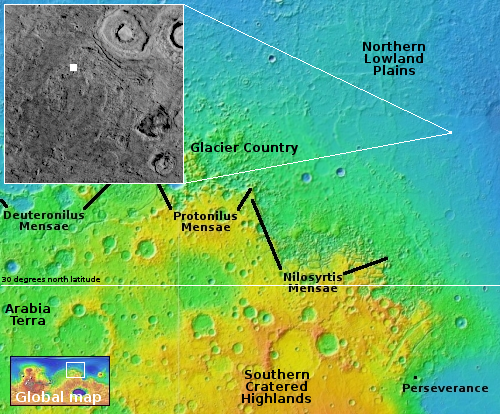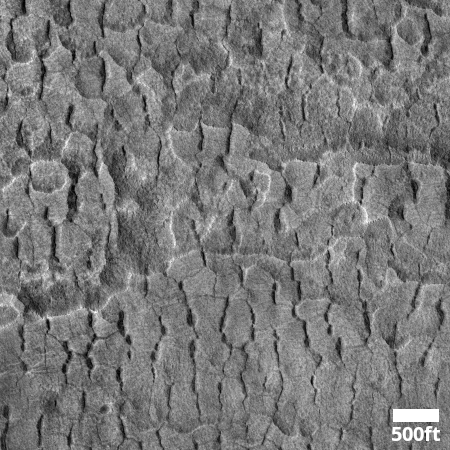Cracking scallops in the Mars
Cool image time! The picture to the right, cropped to post here, was taken on September 27, 2025 by the high resolution camera on Mars Reconnaissance Orbiter (MRO).
The science team labels this “scallop-hosting mantle”. In other words, the surface here has a mantle of material that is for a variety of reason cracking and producing these north-facing scallops. That mantle also appears layered, since it descends downward in terraced steps as you travel north. This particular terrace drops about 40 feet.
Scientists believe [pdf] these scallops are formed in connection with the sublimation of underground ice.
According to [one hypothesis] scallop formation should be ongoing at the present time. Sublimation of interstitial ice could induce a collapse of material, initially as a small pit, then growing southward [in the southern hemisphere] because of greater solar heating on the southern side. Nearby scallops would coalesce together as can be seen to have occurred.
In the case of the image to the right, this sublimation is also accompanied by a drying process similar to cracks one sees in dried mud. As the ice sublimates away the remain material shrinks and cracks.

The white dot on the over view map to the right marks the location, deep within the northern lowland plains of Mars and at the latitude of 46 degrees north. Thus, finding near surface ice here makes sense, as orbital data has routinely found such evidence north of 30 degrees latitude.
What makes this image interesting is the scale of this landscape. I’ve posted a number of cool images of this stuff previously (see here, here, here, and here), all in this same region.
On the overview map, the inset covers an area about fourteen miles square, in which almost the whole surface is scalloped and cracked as you see in the picture above. And this still covers only a small section of this scalloped terrain.
Why the ice is sublimating away at this location, in this manner, is not clear. For some reason the near surface ice is disappearing, but doing so quite evenly across a wide region.
On Christmas Eve 1968 three Americans became the first humans to visit another world. What they did to celebrate was unexpected and profound, and will be remembered throughout all human history. Genesis: the Story of Apollo 8, Robert Zimmerman's classic history of humanity's first journey to another world, tells that story, and it is now available as both an ebook and an audiobook, both with a foreword by Valerie Anders and a new introduction by Robert Zimmerman.
The print edition can be purchased at Amazon or from any other book seller. If you want an autographed copy the price is $60 for the hardback and $45 for the paperback, plus $8 shipping for each. Go here for purchasing details. The ebook is available everywhere for $5.99 (before discount) at amazon, or direct from my ebook publisher, ebookit. If you buy it from ebookit you don't support the big tech companies and the author gets a bigger cut much sooner.
The audiobook is also available at all these vendors, and is also free with a 30-day trial membership to Audible.
"Not simply about one mission, [Genesis] is also the history of America's quest for the moon... Zimmerman has done a masterful job of tying disparate events together into a solid account of one of America's greatest human triumphs."--San Antonio Express-News
Cool image time! The picture to the right, cropped to post here, was taken on September 27, 2025 by the high resolution camera on Mars Reconnaissance Orbiter (MRO).
The science team labels this “scallop-hosting mantle”. In other words, the surface here has a mantle of material that is for a variety of reason cracking and producing these north-facing scallops. That mantle also appears layered, since it descends downward in terraced steps as you travel north. This particular terrace drops about 40 feet.
Scientists believe [pdf] these scallops are formed in connection with the sublimation of underground ice.
According to [one hypothesis] scallop formation should be ongoing at the present time. Sublimation of interstitial ice could induce a collapse of material, initially as a small pit, then growing southward [in the southern hemisphere] because of greater solar heating on the southern side. Nearby scallops would coalesce together as can be seen to have occurred.
In the case of the image to the right, this sublimation is also accompanied by a drying process similar to cracks one sees in dried mud. As the ice sublimates away the remain material shrinks and cracks.

The white dot on the over view map to the right marks the location, deep within the northern lowland plains of Mars and at the latitude of 46 degrees north. Thus, finding near surface ice here makes sense, as orbital data has routinely found such evidence north of 30 degrees latitude.
What makes this image interesting is the scale of this landscape. I’ve posted a number of cool images of this stuff previously (see here, here, here, and here), all in this same region.
On the overview map, the inset covers an area about fourteen miles square, in which almost the whole surface is scalloped and cracked as you see in the picture above. And this still covers only a small section of this scalloped terrain.
Why the ice is sublimating away at this location, in this manner, is not clear. For some reason the near surface ice is disappearing, but doing so quite evenly across a wide region.
On Christmas Eve 1968 three Americans became the first humans to visit another world. What they did to celebrate was unexpected and profound, and will be remembered throughout all human history. Genesis: the Story of Apollo 8, Robert Zimmerman's classic history of humanity's first journey to another world, tells that story, and it is now available as both an ebook and an audiobook, both with a foreword by Valerie Anders and a new introduction by Robert Zimmerman.
The print edition can be purchased at Amazon or from any other book seller. If you want an autographed copy the price is $60 for the hardback and $45 for the paperback, plus $8 shipping for each. Go here for purchasing details. The ebook is available everywhere for $5.99 (before discount) at amazon, or direct from my ebook publisher, ebookit. If you buy it from ebookit you don't support the big tech companies and the author gets a bigger cut much sooner.
The audiobook is also available at all these vendors, and is also free with a 30-day trial membership to Audible.
"Not simply about one mission, [Genesis] is also the history of America's quest for the moon... Zimmerman has done a masterful job of tying disparate events together into a solid account of one of America's greatest human triumphs."--San Antonio Express-News


